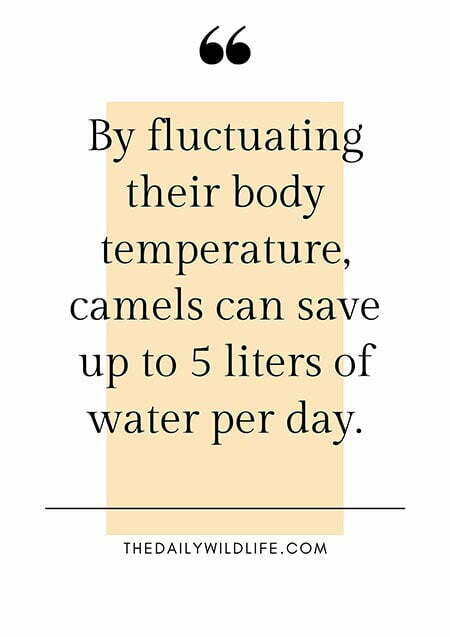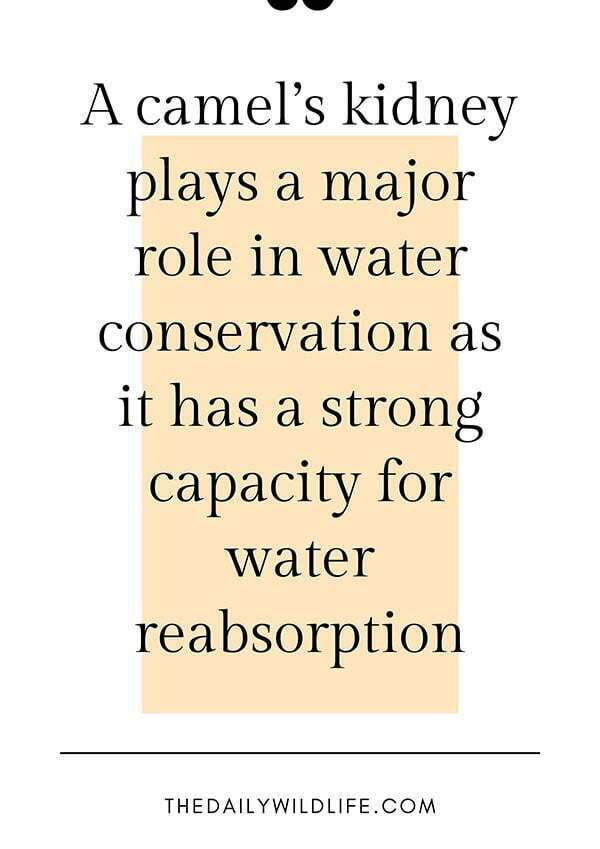Camels produce so little sweat and urine to survive in the desert. Because water is scarce there, reducing the amount of sweating and urinating allows the camels to conserve water while living in this barren area.
The areas camels inhabit can have average temperatures of over 100°F (38°C). And the temperature of the sand is on average 30-40 °F (30-40 °C) higher than the temperature of the air.
Such extreme desert temperatures can lead to a high amount of water evaporating from the body.
Scientists estimate that during the hot summer months, about 85% of the total water losses in camels are from evaporation.
Thanks to their unique physiology, mainly their thick fur, sweat glands, blood cells, and kidneys, camels can survive water loss of over 25% of their body weight. For non-desert mammals, losing over 15% can be lethal. [1]

Why Do Camels Produce So Little Sweat?
Camel’s unique physiology and the relationship between their sweat glands and the fur is the main reason camels sweat little and keep cool.
It was long considered that camels did not sweat at all. Later, scientists discovered sweat glands at the back of the camels’ heads, and though they only perspired there.
That also couldn’t be further from the truth.
Sweat glands are found in all body areas of the camel except in the skin of the upper lip, external nares (nostrils), and perianal region. [2]
And, similar to humans, water removes body heat from sweat glands through evaporation. Vaporization of 1g of water removes about 0.6 Kcal of heat. [3]
In camels, the sweat evaporates directly from the skin surface, which saves more energy and cools the skin more effectively.
Their fur, which can get up to 14.9 inches long (37.5cm), insulates camels from the outside heat. It reduces the amount of heat transferred to the camel’s body from this tropical environment.
Usually, the fur is of a lighter color and very coarse; it reflects the sun rays and prevents the movement of air, which reduces heat transfer to the skin. As a result, the amounts of water required to cool the bodies down, are severely reduced.

Camels also sweat less by changing their body temperature throughout the day.
Instead of losing most of the water during the hot day through sweating, camels can store some of the heat by raising their body temperature to around 105°F (40.7°C).
During the cold part of the day, a camel’s metabolism lowers, making its body temperature fall to around 93°F (34°C).
This difference of 43°F (6.2 °C) between night and day, in a camel weighing 1100 lbs (500 kg), is equivalent to approximately 2 500 kcal. This amount of evaporation would require about 5 liters of sweat, which is saved this way. [4]
Why Do Camels Produce So Little Urine?
Besides reducing the amount of sweat, another water-saving mechanism in camels is the production of very little urine and extremely dry feces.
Scientists calculated that the daily urine volume discharged by dehydrated camels was one-thousandth of the animals’ body weight.
Usually, a camel will urinate between 0.13 and 1.3 gallons per day (0.5 to 5.0 liters), depending on the hydration status. The more dehydrated the camel is, the less it will pee.
Camel’s urine is extremely concentrated, salty, and with very little water content.
A camel’s kidney has a major role in water conservation as it has a strong capacity for water reabsorption.
The long loops of Henle, which are 4-6 times longer than in cattle, have the function of concentrating urine and reducing its flow.
And when a camel is dehydrated, the kidneys will decrease the glomerular filtration rate and increase the tubular reabsorption of water, in an attempt to save as much water as possible.
The little urine that is expelled from the body is used to cool down the back legs.

Read More: Do Monkeys Sweat?
TL;DR: Why Camels Produce Little Sweat And Urine
Camels produce so little sweat and urine to save water and ultimately survive in extreme desert conditions. Camels can fluctuate their body temperature throughout the day, sweat less, pee less, or expel highly concentrated urine with very little water amount, to conserve as much water as possible.
Sometimes, camels will do the opposite of saving water. During a rut, camels will foam at their mouths, urinate frequently, and showcase big water expenditures to seduce the female camels of the herd.
A study has shown that male camels will start the day with a lower body temperature when they are in a rut. This will allow them to display water-spending behavior longer, increase their chances of winning competitions with other males, and mate with more females. [5]
This hypothermia was once thought to be a mechanism for conserving water in very hot dry conditions, but it turned out it can be useful for winning a harem.
This concludes our article on “why do camels produce little sweat and urine“. We hope you enjoyed it and found it interesting.
References
[1] Wu, Huiguang, et al. “Camelid genomes reveal evolution and adaptation to desert environments.” Nature communications 5.1 (2014): 1-10.
[2] Gbolagunte, G. D. “Reclassification of the sweat glands of the one-humped camel (Camelus dromedarius) as apoeccrine based on mode of secretion and extrusion.” Am. J. Res. Commun. 4.5 (2016): 151-170.
[3] MR, Fath El-Bab, A. S. Abou-Elhamd, and M. Abd-Elkareem. “How the structure of the sweat glands of camel symphonizes their reliable function.” J. Anim. Health Prod 5.1 (2017): 19-23.
[4] Bornstein, S. “The ship of the desert. The dromedary camel (Camelus dromedarius), a domesticated animal species well adapted to extreme conditions of aridness and heat.” Rangifer (1990): 231-236.
[5] Grigg, Gordon, et al. “Strategic (adaptive) hypothermia in bull dromedary camels during rut; could it increase reproductive success?.” Biology letters 5.6 (2009): 853-856.